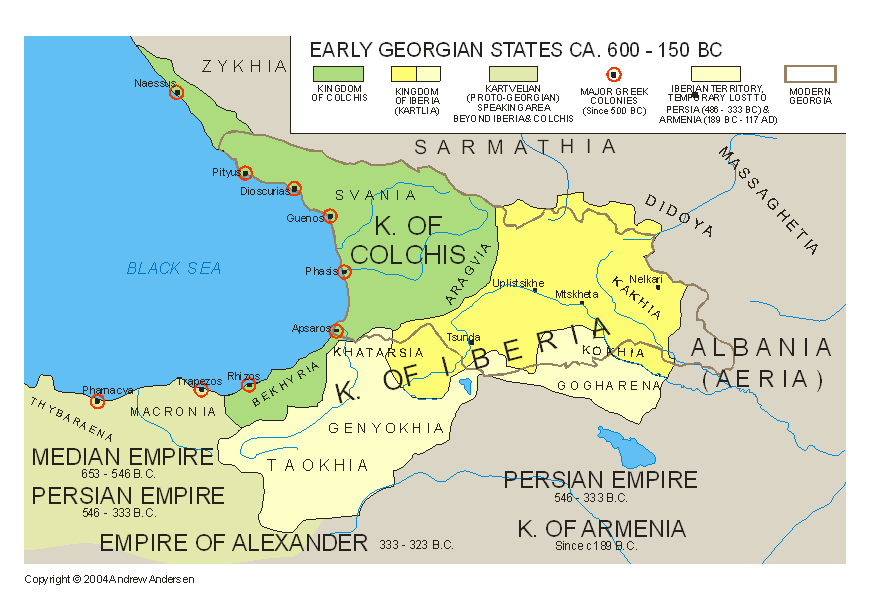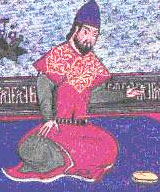|
Siege Of Samshvilde
The siege of Samshvilde was a siege of the city of Samshvilde by the Bishop George of Chqondidi who captured the city on behalf of King David IV. This induced the Seljuks to hastily evacuate most of surrounding districts. Background Samshvilde was the capital of the Kingdom of Tashir-Dzoraget until, Kiurike II, was made captive by King Bagrat IV of Georgia and had to ransom himself by surrendering Samshvilde to the Georgians in 1064. King George II, conceded control of the city to his powerful vassal Ivane I of Kldekari, thereby buying his loyalty, in 1073. Within a year or so, Samshvilde was conquered by the Seljuks under Malik-Shah I. Siege In 1110 the Georgians led by George of Chqondidi, his nephew Theodore, governor of Trialeti, Abuleti and Ivane I Orbeli, retaliated against the Seljuk settlement and recaptured the town of Samshvilde, which was added to the royal domains, without a major battle. Following this capture, the Seljuks left a large part of their occupi ... [...More Info...] [...Related Items...] OR: [Wikipedia] [Google] [Baidu] |
Samshvilde
Samshvilde ( ka, სამშვილდე, ) is a ruined fortified city and archaeological site in Georgia, in the country's south, near the homonymous modern-day village in the Tetritsqaro Municipality, Kvemo Kartli region. The ruins of the city, mostly medieval structures, stretch for a distance of 2.5 km in length and in width in the Khrami river valley. Some of the most recognizable monuments are the Samshvilde Sioni church and a citadel erected on a rocky river promontory. Samshvilde features in the medieval Georgian annals as one of the oldest cities of ancient Kartli, dating back to the 3rd century BC. In the Middle Ages, it was an important stronghold as well as a lively commercial and industrial city. Samshvilde changed hands several times. At the end of the 10th century, it became capital of the Armenian kings of Tashir-Dzoraget and was incorporated in the Kingdom of Georgia in 1064. From the mid-13th century on, as fortunes of the medieval Georgian monarch ... [...More Info...] [...Related Items...] OR: [Wikipedia] [Google] [Baidu] |
Ivane I Of Kldekari
John I ( ka, ივანე) (died c. 1080/89) was an 11th-century Georgian general and duke (eristavi) of Kldekari, Argveti, and Orbeti-Samshvilde of the House of Liparitid-Baguashi from 1059 to 1080/89. Ivane was the son of Liparit IV, Duke of Kldekari, who posed a serious challenge to the power of the Bagratid kings of Georgia. Ivane participated in his father’s struggle against King Bagrat IV whose eventual victory in the 1050s forced Liparit and his family into exile in the Byzantine Empire. Ivane's brother, Niania, had already departed for Ani where he died in the Byzantine service. Ivane likewise offered his service to the imperial administration, being appointed by the emperor Isaac I governor of the city of Erez in the province of Archamouni, near Theodosiopolis (modern Erzurum, Turkey). Ivane capitalized on the withering Byzantine control of eastern Anatolia in the wake of Seljuk attacks and civil tumults to enlarge his fiefdom and occupied two fortresses, Olno ... [...More Info...] [...Related Items...] OR: [Wikipedia] [Google] [Baidu] |
Military History Of Georgia (country)
Before the 10th-century unification of the country by the Bagrationi dynasty, several Georgian states (including Iberia and Colchis) subsisted between the Roman Empire (the Byzantine Empire after the fall of Rome's western half) on the west and the Sassanid Empire (later replaced by the Umayyad and Abbasid Caliphates) on the east. Between the 11th and 15th centuries, the Kingdom of Georgia was a major regional power which withstood invasions by the Seljuk, Mongol and Timurid Empires before its fragmentation and submission to the Ottoman and Safavid Empires. Many Georgians fought in the armies of empires that ruled the country since the 16th century, be it the Safavids (and successive Afsharids and Qajars), the Russian Empire or the Soviet Union. Since 1991, independent Georgia has taken part in a number of wars; its modern-day conflict with Russia began in 1992 (war in Abkhazia) and culminated in the 2008 Russo–Georgian War, and its alliance with the United States led to ... [...More Info...] [...Related Items...] OR: [Wikipedia] [Google] [Baidu] |
Battle Of Trialeti
The Battle of Trialeti, fought in 1110, was a conflict between the Kingdom of Georgia and the Seljuk Empire. Following the Georgian capture of Samshvilde and Dzerna in the same year, the Sultan of the Seljuk Empire dispatched an army of 100,000 troops to Georgia. However, this force was defeated by a Georgian army of 1,500 men, led by King David IV, in the Battle of Trialeti. Background and battle In 1110, the Kingdom of Georgia, led by George of Chqondidi's nephew Theodore and Kakhetian nobleman Abuleti, launched a retaliation against the Seljuk occupation. They successfully recaptured the heavily fortified town of Samshvilde, followed by the liberation of the Kura valley. In the wake of this victory, the Seljuks abandoned much of their previously captured territories, enabling Georgian forces to seize the town of . In response to these defeats, in 1110 Sultan Muhammad I Tapar unexpected invaded Georgia with an army of 100,000 men. David IV, responded to the invasion by s ... [...More Info...] [...Related Items...] OR: [Wikipedia] [Google] [Baidu] |
Muhammad I Tapar
Muhammad I Tapar (, ; 20 January 1082 – 18 April 1118), was the sultan of the Seljuk Empire from 1105 to 1118. He was a son of Malik-Shah I () and Taj al-Din Khatun Safariya. Reign Muhammad was born in 20 January 1082. He succeeded his nephew, Malik Shah II, as Seljuq Sultan in Baghdad, and thus was theoretically the head of the dynasty, although his brother Ahmad Sanjar in Khorasan held more practical power. Muhammad I probably allied himself with Radwan of Aleppo in the battle of the Khabur River against Kilij Arslan I, the sultan of Rüm, in 1107, in which the latter was defeated and killed. Following the internecine conflict with his half brother, Berkyaruq, he was given the title of ''malik'' and the provinces of Armenia and Azerbaijan. Dissatisfied by this he revolted again, but had to flee back to Armenia. By 1104, Berkyaruq, ill and tired of war, agreed to divide the sultanate with Muhammad. Muhammad became sole sultan following the death of Berkyaruq in 1105. In ... [...More Info...] [...Related Items...] OR: [Wikipedia] [Google] [Baidu] |
Trialeti
Trialeti ( ka, თრიალეთი ) is a mountainous area in central Georgia Georgia most commonly refers to: * Georgia (country), a country in the South Caucasus * Georgia (U.S. state), a state in the southeastern United States Georgia may also refer to: People and fictional characters * Georgia (name), a list of pe .... In Georgian, its name means "a place of wandering". The Trialeti Range is a part of the greater Trialeti Region. It corresponds to the modern-day Tsalka Municipality. {{Subregions of Tao-Klarjeti Geography of Georgia (country) Former provinces of Georgia (country) Historical regions of Georgia (country) ... [...More Info...] [...Related Items...] OR: [Wikipedia] [Google] [Baidu] |
Georgians
Georgians, or Kartvelians (; ka, ქართველები, tr, ), are a nation and Peoples of the Caucasus, Caucasian ethnic group native to present-day Georgia (country), Georgia and surrounding areas historically associated with the Georgian kingdoms. Significant Georgian diaspora communities are also present throughout Georgians in Russia, Russia, Georgians in Turkey, Turkey, Georgians in Greece, Greece, Iranian Georgians, Iran, Georgians in Ukraine, Ukraine, the Georgian Americans, United States, and the European Union. Georgians arose from Colchis, Colchian and Kingdom of Iberia (antiquity), Iberian civilizations of classical antiquity; Colchis was interconnected with the Ancient Greece, Hellenic world, whereas Iberia was influenced by the Achaemenid Empire until Alexander the Great conquered it. In the early 4th century, the Georgians became one of the first to Christianization of Iberia, embrace Christianity. Currently, the majority of Georgians are Eastern Orthodo ... [...More Info...] [...Related Items...] OR: [Wikipedia] [Google] [Baidu] |
Malik-Shah I
Malik-Shah I (, ) was the third sultan of the Seljuk Empire from 1072 to 1092, under whom the sultanate reached the zenith of its power and influence. During his youth, he spent his time participating in the campaigns of his father Alp Arslan, along with the latter's vizier Nizam al-Mulk. During one such campaign in 1072, Alp Arslan was fatally wounded and died only a few days later. After that, Malik-Shah was crowned as the new sultan of the empire, but the succession was contested by his uncle Qavurt. Although Malik-Shah was the nominal head of the Seljuk state, Nizam al-Mulk held near absolute power during his reign. Malik-Shah spent the rest of his reign waging war against the Karakhanids to the east and establishing order in the Caucasus. The cause of Malik-Shah's death remains under dispute to this day; according to some scholars, he was poisoned by Abbasid caliph al-Muqtadi, while others say that he was poisoned by the supporters of Nizam al-Mulk. Etymology Although ... [...More Info...] [...Related Items...] OR: [Wikipedia] [Google] [Baidu] |
George II Of Georgia
:''There was also a Giorgi II, Catholicos of Kartli who ruled in 826–838.'' George II ( ka, გიორგი II, tr) ( 1050 – 1112), of the Bagrationi dynasty, was a king (''mepe'') of Georgia from 1072 to 1089. He was a son and successor of Bagrat IV and his wife Borena of Alania. Unable to deal effectively with the constant Seljuk Turkish attacks and overwhelmed by internal problems in his kingdom, George was forced to abdicate in favor of his energetic son David IV, to whom he remained a nominal co-ruler until his death in 1112. He also held the high Byzantine titles of '' curopalates'' (c. 1060) and ''caesar'' (c. 1081). Early reign George's childhood coincided with the civil war between his father, Bagrat IV (r. 1027–1072), and the rebellious Georgian feudal lord Liparit, who succeeded in temporarily driving Bagrat into the Byzantine Empire, and crowned George as king at the Ruisi cathedral between 1050 and 1053, under the regency of Bagrat's sister Gurandukh ... [...More Info...] [...Related Items...] OR: [Wikipedia] [Google] [Baidu] |
Georgian–Seljuk Wars
The Georgian–Seljuk wars ( ka, საქართველო-სელჩუკთა ომები, tr), also known as Georgian Crusade, is a long series of battles and military clashes that took place from 1064 until 1213, between the Kingdom of Georgia and the different Seljuk Empire, Seljukid states that occupied most of South Caucasus. The conflict is preceded by deadly raids in the Caucasus by the Turks in the 11th century, known in Georgian historiography as the Great Turkish Invasion. Background In 1048–9, the Seljuk Empire, Seljuk Turks under Ibrahim Inal, Ibrahim Yinal made their first incursion in Byzantine Empire, Byzantine frontier region of Iberia (theme), Iberia. The emperor Constantine IX Monomachos, Constantine IX requested help from the Georgian duke Liparit IV, Duke of Kldekari, Liparit IV of Kldekari, whom the Byzantines had aided in his Byzantine–Georgian wars#Liparit IV of Kldekari, struggle against the Georgian king Bagrat IV of Georgia, Bagrat IV ... [...More Info...] [...Related Items...] OR: [Wikipedia] [Google] [Baidu] |





